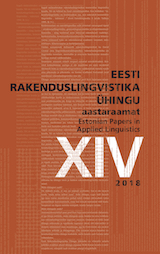Acquisition of noun derivation in Estonian and Russian L1
Acquisition of noun derivation in Estonian and Russian L1
Author(s): Reili Argus, Victoria KazakovskayaSubject(s): Morphology, Lexis, Language acquisition, Pragmatics, Comparative Linguistics
Published by: Eesti Rakenduslingvistika Ühing (ERÜ)
Keywords: language acquisition; noun derivation; building-block model; acquisition of non-formation patterns; Russian; Estonian;
Summary/Abstract: Acquisition of derivation is not a well-studied area in first language research and a comparative approach to the acquisition of derivation in different languages doesn’t exist. There is no information on how a child acquires derivation in a language with a rich and regular system of derivational patterns, or in a language where derivation is productive, but the system of derivational patterns is opaque. According to general ideas of complexity in a language, the child should start to use simplex stems first and, only after that, complex ones, that is, complexity should increase in the course of acquisition. Our paper is intended to address these issues, based on longitudinal child data from typologically different languages, Estonian and Russian. The results revealed significant differences in the acquisition of noun derivation in the two languages under observation. The system of noun derivation is acquired at a faster pace in Russian, while Estonian children have far fewer noun derivatives in their speech and they use different derivation suffixes with less regularity. Even so, the so-called building block model may be applied for both languages only partially.
Journal: Eesti Rakenduslingvistika Ühingu aastaraamat
- Issue Year: 2018
- Issue No: 14
- Page Range: 23-39
- Page Count: 17
- Language: English

